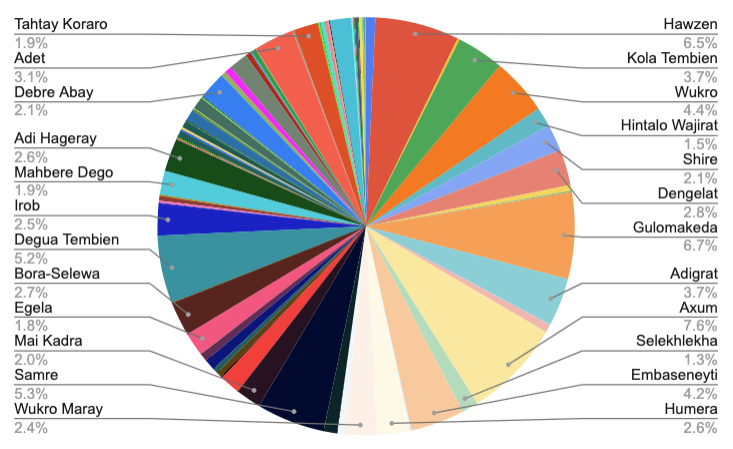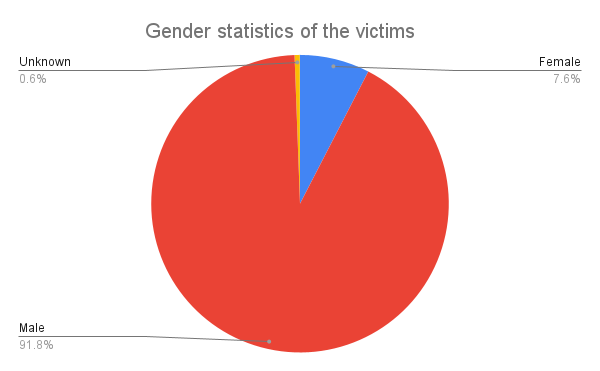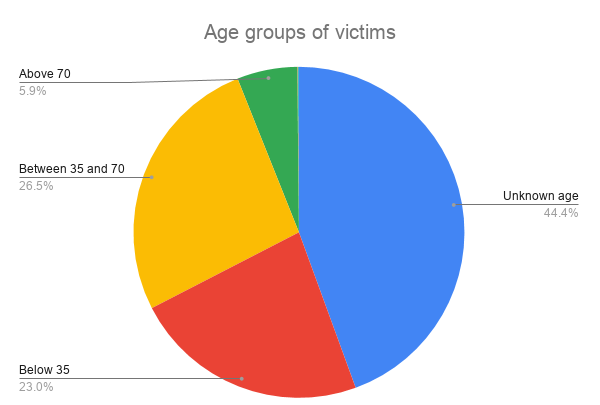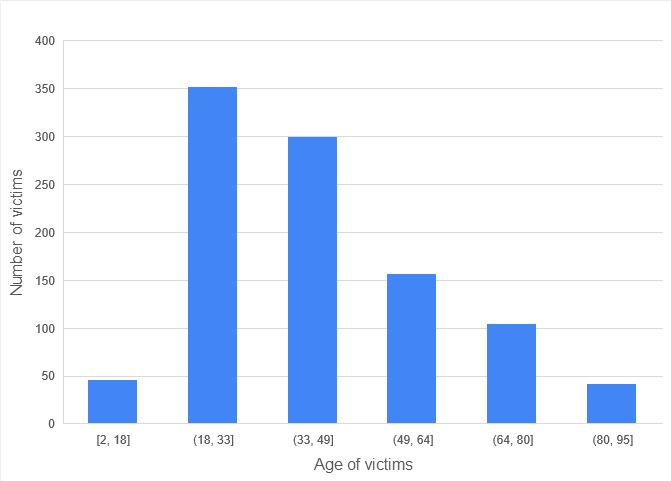Below is analysis by Tghat
It is an attempt to put together the information available - and makes clear the problems of incomplete data.
Martin
The War on Tigray in Numbers: Initial Analysis of Civilian Massacres
Since the outbreak of COVID-19 was declared as a global pandemic in March 2020, the world has been preoccupied with addressing the spread of the virus and saving lives. While this pandemic has resulted in untold personal tragedy and significant challenges for many nations, it has also been an opportunity for a few autocrats and dictators seeking to consolidate political power. Abiy Ahmed Ali of Ethiopia was one of those leaders who saw the opportunity presented by the pandemic to unconstitutionally extend his term limit and postpone the national elections scheduled for August 2020.
The Government of Tigray, however, made it clear early in May 2020 that Tigray was moving ahead with plans to hold elections according to the constitution of the country. In a televised speech on 07 May 2020, Abiy Ahmed threatened “Those pushing for unconstitutional ways to grab power will be punished by law”. He added, “Young people should not die, mothers should not cry and houses should not be demolished just so politicians can take power.” This warning was understood at that time to be addressing the election proposed in Tigray and the political parties which had rejected the unconstitutional postponement of the election and were calling for the formation of a transitional government.
Despite these threats, the government of Tigray refused to illegally extend its mandate and went ahead with regional elections. Accordingly, the Tigray region went to the polls on 9 September 2020. Pre-election campaigning as well as the voting process on election day took into account social distancing guidelines and sanitizing precautions demonstrating it was possible to hold elections during COVID with reasonable precautions. The Ethiopian government declared Tigray’s elections unconstitutional and went on to extend its term for an unconstitutional sixth year. It was in this context that Abiy Ahmed declared war on Tigray early in the morning of the 4th of November 2020. He proceeded to launch a full-blown attack by the Ethiopian National Defense Forces (ENDF), backed by the Amhara special forces and Militia.
Abiy Ahmed promised that his war on Tigray was a surgical “law enforcement operation” and he declared this operation to be over on the 28th of November when his army entered Mekelle. In a subsequent speech, delivered to the House of People’s Representatives on 30 November 2020, Abiy claimed no civilians had been killed in the offensive. A joint press release by three Tigrayan political parties on 02 February 2021, however, revealed that an estimated 52, 000 Tigrayan civilians had been killed from November 2020 to January 2021. Since then several well-researched and exceedingly credible reports by the international media and human rights organizations have detailed atrocity crimes committed in Tigray by the invading forces including dozens of documented massacres of unarmed civilians. Some of the most notable reports that came out of Tigray include the Amnesty International and Human Rights Watch reports on the Axum massacres; the CNN international report on Dengelat massacres; BBC and CNN reports on the Mahbere Dego massacres; The Telegraph report on Adigrat massacres; The Telegraph reports on Idaga Hamus massacres and Abi Addi massacres; Sky News report about the Cheli massacres; the coverage of the massacre of 9 civilians, mostly women and children, near Abuna Yemata church on 08 May 2021 by the The Guardian. Other credible sources have also reported about the killings of civilians in other places of Tigray. These reports include a preliminary report on Adi Hageray massacres, Goda massacre in Adigrat, Adigrat Addis Pharmaceuticals Factory massacre, Debre Abay massacres, Zalambessa massacres, Irob massacres, Samre massacres, Mekelle massacres, etc.
Other war crimes were also documented by many outlets including the ground coverage by Channel 4 News which recorded testimonies of alleged war crimes. Alleged war crimes include shelling and airstrikes conducted by the air force against civilian areas. The most widely publicized of this has been the bombing of the market town of Togoga in Degua Tembien on market day on 22 June 2021. More than 64 people have been reported killed among them women and children of ages from 2 to 65 according to eyewitnesses and local health officers. The airstrike has also left more than 180 civilians injured.
Massacres and indiscriminate killings of Tigrayan civilians were persistent elements in all parts of Tigray occupied by Ethiopian, Eritrean and Amhara forces. For example, on 23 March 2021, staff members of the MSF (Médecins Sans Frontières, Doctors Without Borders) witnessed the extrajudicial killings of four civilians who were dragged off public buses and executed by Ethiopian government soldiers on the road from Mekelle to Adigrat. According to the witnesses, the MSF team’s driver was also pulled out from the car, beaten with the back of a gun, and threatened to be killed by the soldiers. On the same day, the Ethiopian soldiers stopped two public transport minibusses and shot dead 21 civilians (a graphic video can be found here). The Danish Refugee Council (DRC), International Rescue Committee (IRC), and MSF humanitarian aid workers who were helping the communities affected in Tigray are also victims of the war on Tigray.
Nine months after Abiy Ahmed declared the war on Tigray over, the war not only continues, it has intensified. Even as Tigray Defense Forces (TDF) have recaptured large parts of Tigray, atrocity crimes continue in the occupied Western Tigray. The Ethiopian government has also imposed an almost total siege blocking humanitarian aid into Tigray and instituted mass arrests of Tigrayans across the country, including in the capital Addis Ababa.
Here, we present the districts and demographic analysis of the more than 3000 civilian victims identified so far across different places in Tigray. Our team at Tghat does the work of collecting facts from relatives of the victims who live in Tigray, the diaspora and other parts of Ethiopia, eyewitnesses, and testimonies on the ground to reflect exactly what happened. In some cases, we directly talk to close family members of the victims. This helps us to verify some of the information we compiled from social media posts.
We document as complete information as possible including the full names, gender, and ages of the victims. In addition to this, we also document the exact name of places where the killings took place, the sources of the information, acts of killings (whether the victim was killed, murdered, executed, or died due to lack of medicine), additional information about the killing (e.g., perpetrators who commit the crimes, stories behind the victims), and photos of the victims (only when available). The ages of the victims and the information about the perpetrators have helped us to understand the patterns that have emerged from the data we have collected so far. From the compiled data, we can understand that many more men, especially young men, are being killed than women. The actual list of casualties we have collected so far is about 5.8% of the estimate of civilians killed arrived at by the three Tigrayan political parties in February 2021. We stand by the veracity of the victims data we have compiled so far. Even though international media and organizations have not been able to fully catalogue and independently verify a great percentage of massacres, the reports listed above support the pattern of indiscriminate killings and massacres of innocent civilians that we have been able to document. The limited information disclosed by the government of Ethiopia through the Ethiopian Human Rights Commission about the massacres in Axum, Humera, Dansha, and Bissober also supports our findings.
It bears noting that the Ethiopian regime persists in official denial of these widely corroborated atrocities as evidenced in the press release of 10 May 2021, by the Ethiopian Attorney General’s (AG) office. This statement misrepresented the most credibly established Axum Massacre perpetrated by Ethiopian and Eritrean soldiers in late November 2020 stating that the victims were Tigray Liberation Front (TPLF) fighters who died in clashes with the invading Eritrean soldiers. Amnesty International, rightly expressed its deep concern about these efforts by this misrepresentation in a public statement released on 13 May 2021, Amnesty also warned that findings like this indicate that credible outcomes through domestic efforts at investigating and ensuring accountability for the grave atrocities committed in Tigray will remain elusive. In addition to this, the Human Rights Watch has called again for a robust and independent international investigation of the atrocities committed in Tigray. On 19 May 2021, the US Senate also passed a resolution condemning all violence against Tigrayan civilians and calling for the full withdrawal of the invading Eritrean soldiers.
Data Collection Challenges
We have many challenges and obstacles in collecting the data and putting together the list of victims. Some of these main challenges include the following:
- Given the communication blackout in Tigray, it is difficult to reach people, especially in the rural areas, for verification of the alleged victims and the death toll across different districts.
- People are not inclined to share data. This, we believe, comes from the general lack of understanding about the power of data in the digital era.
- Some social media users don’t provide complete information about the victims and the crimes committed by the perpetrators when they post the incident on social media.
- Fear. Since the Ethiopian government of Abiy Ahmed has very tight control of the telecommunications and Internet access to Tigray, many family members of the victims don’t want to share the actual information for fear of being the target by the government.
- It is difficult to pinpoint the actual dates and locations given the circumstances.
- Incomplete information collected from third-party is very difficult to verify.
- Some areas under the invading forces are too risky to speak to people about the casualties.
Figure 1 shows districts with the most civilians killed. The identified number of victims ranked by the districts with the most people killed where the number of victims is more than 30 is shown in Table 1. As shown in Figure 1, 7.6% of the identified victims so far are from the city of Axum and the surrounding areas. Other districts hit by the massacre are for example Gulomakeda, Hawzen, Samre, Degua Tembien, Wukro, Embaseneyti, Adigrat, Kola Tembien, Adet, Dengelat, Bora-Selewa, Adi Hageray, Humera, Wukro Maray, Irob, Debre Abay, Shire, Mai Kadra, Tahtay Koraro, Mahbere Dego, Egela, Chilla, Sheraro, Hintalo Wajirat, Mai Kinetal, and Selekhlekha. For more detailed information, refer to Figure 1 and Table 1.

| Place of Killing | Total Number of Victims | Remark |
| Axum | 221 | Civilian victims from the city of Axum and the surrounding areas. |
| Gulomakeda | 194 | Civilian victims from the district of Gulomakeda across different areas. |
| Hawzen | 189 | Civilian victims from the districts of Hawzen across different areas. |
| Samre | 154 | Civilian victims from the districts of Samre and Saharti-Samre. |
| Degua Tembien | 152 | Civilian victims from the district of Degua Tembien across different areas. |
| Wukro | 125 | Civilian victims in the city of Wukro and the surrounding areas. |
| Embaseneyti | 121 | Civilian victims from the districts of Embaseneyti across different areas. |
| Adigrat | 108 | Civilian victims from the city of Adigrat and the surrounding areas. |
| Kola Tembien | 106 | Civilian victims from Kola Tembien across different areas. |
| Adet | 90 | Civilian victims from the district of Adet across different areas. |
| Dengelat | 80 | Civilian victims from Dengelat. |
| Bora-Selewa | 77 | Civilian victims from the district of Bora-Selewa across different areas. |
| Adi Hageray | 74 | Civilian victims from Adi-Hageray. |
| Humera | 74 | Civilian victims from Humera. |
| Wukro Maray | 71 | Civilian victims from Wukro Maray across different areas. |
| Irob | 70 | Civilian victims from the district of Irob across different areas. |
| Debre Abay | 61 | Civilian victims from Debre Abay. |
| Shire | 60 | Civilian victims from Shire and the surrounding areas. |
| Mai Kadra | 57 | Civilian victims from Mai Kadra. |
| Tahtay Koraro | 55 | Civilian victims from the district of Tahtay Koraro across different areas. |
| Mahbere Dego | 54 | Civilian victims from Mahbere Dego |
| Egela | 53 | Civilian victims from the district of Egela across different areas. |
| Chilla | 48 | Civilian victims from the district of Chilla across different areas. |
| Sheraro | 46 | Civilian victims from Sheraro across different areas. |
| Hintalo Wajirat | 44 | Civilian victims from Hintalo Wajirat. |
| Mai Kinetal | 43 | Civilian victims from the district of Mai Kinetal across different areas. |
| Selekhlekha | 37 | Civilian victims from Selekhlekha. |

The chart in Figure 2 shows that 91.8% of the victims were males, 7.6% of them were females while the gender of the remaining 0.6% has not been identified so far. At first glance, this may give the impression that women and girls were not targeted as much as men were, but the truth is that the invading soldiers used rape and sexual violence to break the spirit and bodies of the Tigrayan women and bullets to kill the bodies of the Tigrayan men. The weaponized rape in Tigray has been widely reported by many international media organizations. These include credible reports from CNN, Channel 4 News, DW, Al Jazeera, and France24.

Despite the communications blackout that lasted for months in the entire Tigray region, which made it difficult to collect accurate and detailed information, we have managed to identify the ages of the victims as shown in Figure 3. As we can see from Figure 3, the ages of 55.6% of the victims are known, and our team is continuously updating the data to fill in the missing information about the ages of the remaining 44.4%.

The chart in Figure 43 shows the age statistics of massacred civilians. The age distribution of the victims whose age has been identified illustrates a clear and shocking pattern. More than two-thirds of the victims are between the ages of 18 and 49, the most productive age bracket in the society. The pattern reveals the intent of the perpetrators. Some of them have clearly stated what they were up to.
The Eritrean soldiers said they were ordered to kill any male over the age of 14. According to a soldier, the order they received from their superiors was to kill those who “pee against the wall” – a reference to men.
SOURCE: THE AFRICAN REPORT
We also found out that the median age statistics of the victims is 38. Children and the elderly were not, however, spared. We found out that the youngest victims are of age 2 and the oldest unarmed civilian victims are in their 90s. The massacres are beyond the loss of lives of the victims. The targeting of men of the most productive age will have ramifications that will last for generations in the Tigrayan society.
There is still another round of massacres and extrajudicial killings of innocent civilians in Tigray. We document the continuous massacres of civilians, and the verified list of victims we compiled so far from different sources can be found here.
Sadly, this is just a drop in the bucket!
We want to know where the 17K plus Tigrayans members of EDF have been taken; are they dead or alive? We demand the International Community to investigate and if not permitted to do so, then force must be used until all are accounted for, whether dead or alive!!.
Not sure if the world realizes that TDF must continue to enter Ethiopian towns/cities until ALL EDF’s members of Tigray origin are accounted for, again, whether dead or alive!
This is NOT a WAR!
This is a horrible campaign to destroy a race; to destroy Tigrayans!
To those Amharas who might read this: why are you so proud of a man who in less than 3 years has destroyed the Ethiopia we knew & loved? For the 27 years prior to now, we lived in peace; we traveled in peace; we traded in peace; we got married, danced & sang in peace; our children went to school in peace…but now?? Is this okay with you?
Ere ere! YibeKal!
Please! No More!
Keep Ethiopia and let us live in peace! You for the sake of your future generations and us for the sake of our future generations.